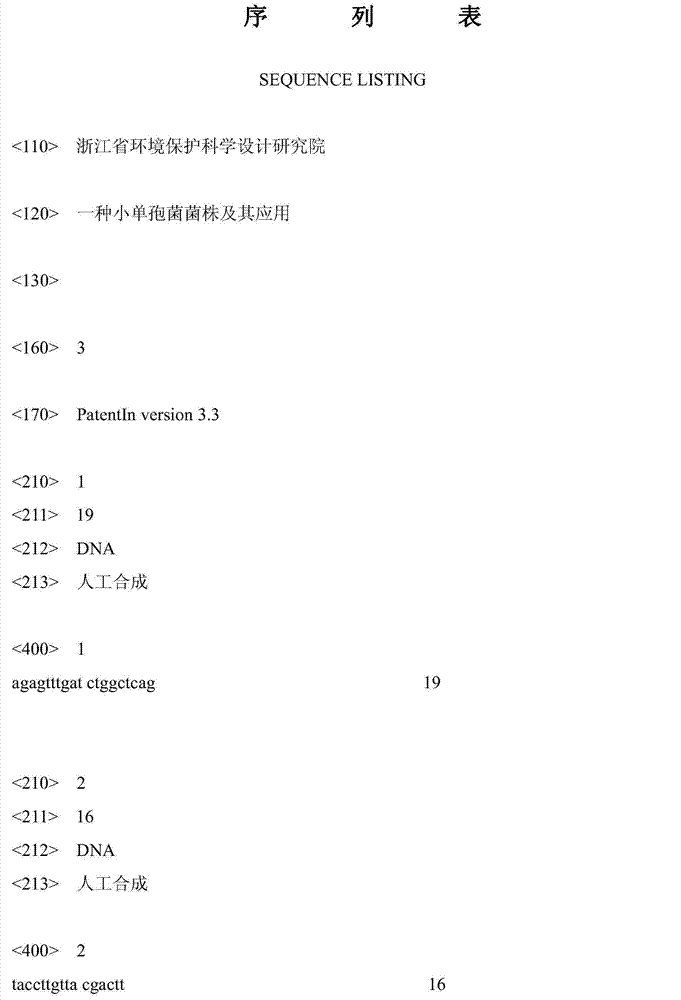Micromonospora and application thereof
A technology of Micromonas and Micromonas, applied in bacteria, water/sludge/sewage treatment, biochemical equipment and methods, etc., to achieve the effect of wide degradation spectrum, protection of ecological environment and good treatment effect
- Summary
- Abstract
- Description
- Claims
- Application Information
AI Technical Summary
Problems solved by technology
Method used
Image
Examples
Embodiment 1
[0041] Example 1 Obtaining and identification of actinomycete Micromonospora orange (Micromonospora aurantiaca) ZHY1-5
[0042] 1. Acquisition and identification of strains
[0043] (1) Preliminary screening: Take 10g of activated sludge from the wastewater treatment system for producing terpene resins, inoculate it in an inorganic salt liquid medium containing 200mg / L α-pinene, enrich and cultivate it on a shaking table at 30°C and 160rpm for 5 days, Take 1 mL of the enriched bacteria liquid and inoculate it into a new liquid medium containing the same concentration of α-pinene, and then enrich it twice. Then take 1mL of the bacterial solution and carry out gradient dilution with sterile water, spread it on the inorganic salt medium containing 200mg / L α-pinene, incubate the plate upside down at 30°C, observe the growth of a single colony on the plate, and then pick different shapes, Colonies with the same color were observed under a microscope, and the colonies with the same...
Embodiment 2
[0057] Example 2 Degradation of different compounds by bacterial strain ZHY1-5 in inorganic salt-based liquid medium
[0058] (1), pick a ring of bacteria from the plate and inoculate it in a liquid growth medium (liquid LB medium), cultivate it to the logarithmic growth phase at 35° C., 160 rpm, collect the bacteria by centrifugation at 12000 rpm, wash 3 times with sterile water, Adjust OD after resuspension in sterile water 600 To 1.5, inoculate 3mL into the inorganic salt liquid medium with 200mg / L of various organic matter as the sole carbon source respectively, put 100mL medium in a 250mL shaker flask, culture at 30°C, 180rpm shaker for 48h, then take samples for measurement For the degradation rate of different substrates, the blank without inoculation was used as the control.
[0059] (2) The organic pollutants added in the inorganic salt medium are BTEX benzene series (benzene, toluene, ethylbenzene, o-xylene, m-xylene, p-xylene), petroleum ether, cyclohexane, n-hexen...
Embodiment 3
[0065] The treatment effect of embodiment 3 bacterial strain ZHY1-5 to terpene resin production wastewater
[0066] Pick a ring of bacteria from the plate and inoculate it in a liquid growth medium (liquid LB medium), cultivate it to the logarithmic growth phase at 35°C, 160rpm, collect the bacteria by centrifugation at 12000rpm, wash 3 times with sterile water, weigh OD after suspension 600 to 1.5.
[0067] Take the activated sludge of the sewage treatment plant of the terpene resin production enterprise and the effluent of the sewage treatment plant. The COD of the effluent is about 563.44mg / L. Put 250mL of the effluent of the sewage treatment plant in a 500mL triangular bottle, and the amount of activated sludge is 30%. Dosing, inoculate 1%, 2%, and 3% fresh strains respectively, control without adding bacteria, culture at 30°C, 180rpm for 48h, let stand, pour off 100mL of supernatant, then add the same volume of effluent, 30°C, Cultivate at 180rpm for 48h, and measure th...
PUM
| Property | Measurement | Unit |
|---|---|---|
| clearance rate | aaaaa | aaaaa |
Abstract
Description
Claims
Application Information
 Login to View More
Login to View More - R&D
- Intellectual Property
- Life Sciences
- Materials
- Tech Scout
- Unparalleled Data Quality
- Higher Quality Content
- 60% Fewer Hallucinations
Browse by: Latest US Patents, China's latest patents, Technical Efficacy Thesaurus, Application Domain, Technology Topic, Popular Technical Reports.
© 2025 PatSnap. All rights reserved.Legal|Privacy policy|Modern Slavery Act Transparency Statement|Sitemap|About US| Contact US: help@patsnap.com



